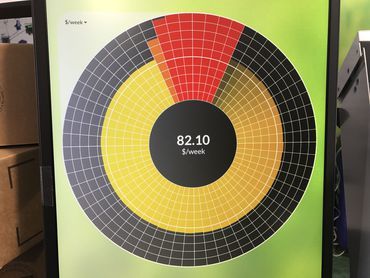We’ve seen plenty of systems capable of tracking your home’s energy usage, and even spent some time testing one of them out in the CNET Smart Home. It’s a patently good idea, but to date, we haven’t seen a product that really nails the execution yet.
That’s why I was so intrigued by what I heard from Curb, an Austin-based startup that’s working to bring whole-home energy tracking to the masses. Curb founder and CEO Erik Norwood walked me through the system’s ins and outs in a booth off the beaten path here at CES, and the more I listened, the more encouraged I became.
The core device is a $400 gadget that sits inside of your breaker box, with special sensors that clamp onto each circuit to track how much power they’re putting out. Curb feeds that data to the cloud, letting you monitor everything in real time on your computer, or on your phone using Curb’s app.
Curb’s sensors clamp onto each circuit and track how much power is flowing through them.
Ry Crist/CNETThat’s not dramatically different than other players in the space, including Neurio, the system we reviewed back in 2015. And, like those competitors, you’ll need to hire an electrician to install everything. From hands-on accounts on the web, that could take as long as 3 hours, and if you figure roughly $100 per hour for a good electrician’s time, that adds up fast.
Curb’s creators recognize that those installation woes are a major friction point for adoption. To that end, they came to Vegas with a potentially significant new partner: Schneider Electric. You might never have heard of it (I hadn’t before this week), but it’s the name behind the largest manufacturer of residential breaker boxes. That could help Curb get its gadget installed in people’s homes before they even move in.
Curb’s app has a radar-like display that tracks your energy usage on a second-by-second basis. Here, we turned a space heater on and saw consumption jump into the red.
Ry Crist/CNETAnother strong point: Curb’s software. Both the app and the web portal visualize your home’s energy usage especially well, with a spinning radar-like display that shows your power consumption on a second-by-second basis. You can also view your usage over time, with stacked graphs that offer a clean breakdown of your consumption.
That data also makes Curb something of a connected home-enabler. After all, once you can track everything’s power usage, you’ll have an extra incentive to smarten all of it up so that you can automate it, or turn it off remotely.
“We don’t want to make switches and thermostats to compete with Samsung and Nest,” Norwood said. “We’d rather be the conductor of the symphony.”
To that end, Curb boasts an integration with Samsung’s SmartThings connected home platform. Enable it, and you’ll be able to turn your SmartThings-enabled lights and appliances on and off directly from Curb’s web portal or app — an easy way to take action as you comb through Curb’s energy-tracking data.
I also like that, in addition to tracking energy consumption, Curb can track the energy production of any solar panels you might have installed. That’s a good, forward-thinking feature for energy-conscious consumers.
Curb is available now in the US, and I think it’s worth keeping on your radar. I’m itching to test it out in the CNET Smart Home — when that time comes, we’ll let you know all of the ins and outs.


































































